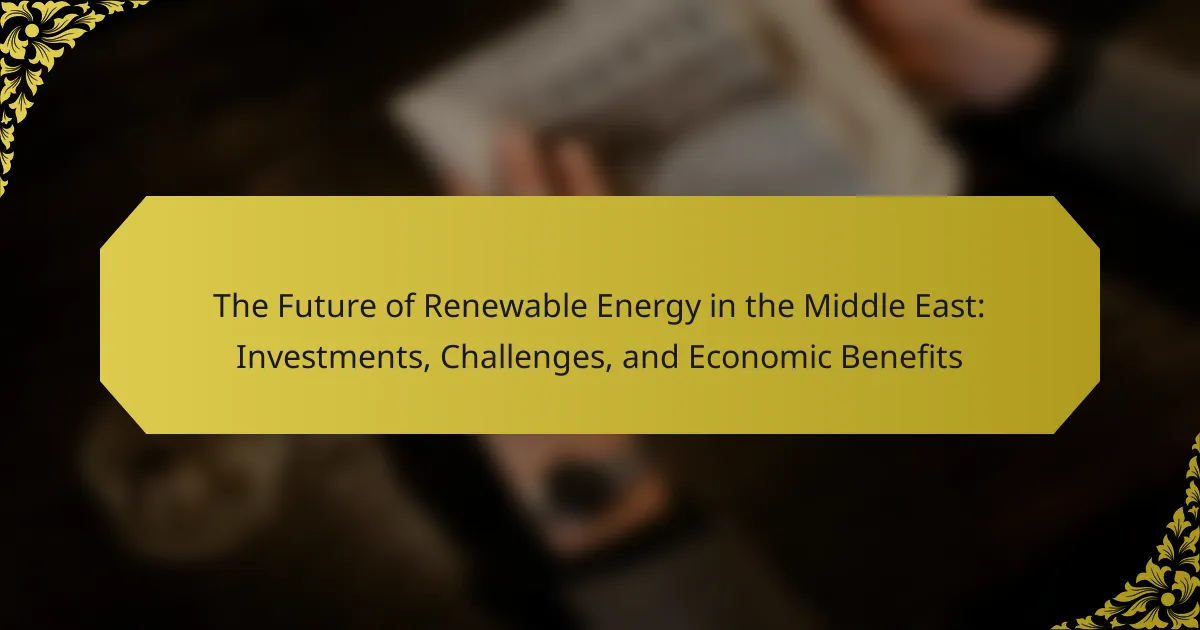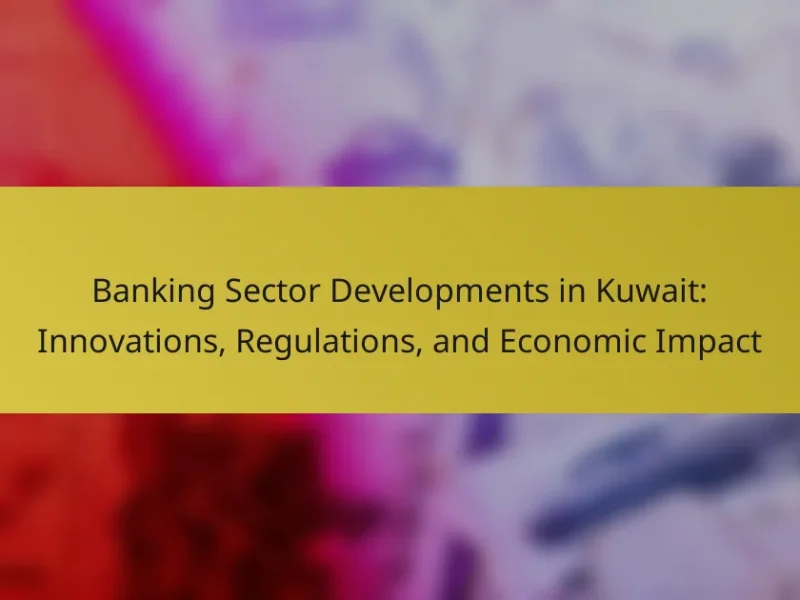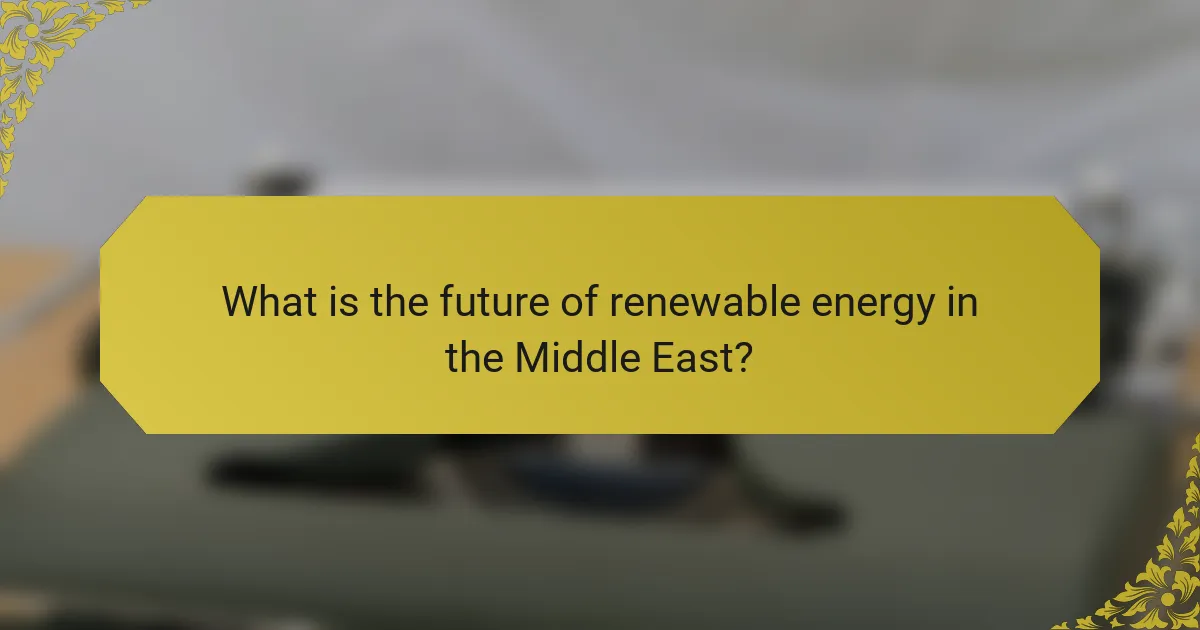
What is the future of renewable energy in the Middle East?
The future of renewable energy in the Middle East is promising and dynamic. Countries in the region are investing heavily in solar and wind energy. For instance, Saudi Arabia aims to generate 58.7 GW of renewable energy by 2030. The United Arab Emirates has committed to producing 44% of its energy from clean sources by 2050. These initiatives are driven by the need to diversify economies and reduce dependence on oil. Additionally, the region’s abundant sunlight makes it ideal for solar energy projects. Investments in renewable technologies are expected to create jobs and stimulate economic growth. The Middle East is becoming a global hub for renewable energy innovation.
How is renewable energy defined in the context of the Middle East?
Renewable energy in the context of the Middle East is defined as energy derived from natural processes that are continuously replenished. This includes solar, wind, geothermal, and hydropower sources. The region is particularly rich in solar energy potential due to its high levels of sunlight. Countries like the UAE and Saudi Arabia are investing heavily in solar farms to diversify their energy sources. Wind energy is also being explored, especially in coastal areas. The Middle East aims to reduce reliance on fossil fuels and lower carbon emissions. According to the International Renewable Energy Agency, the region’s renewable energy capacity is expected to grow significantly in the coming years. This transition is essential for sustainable development and economic diversification.
What are the key types of renewable energy sources utilized in the region?
The key types of renewable energy sources utilized in the Middle East are solar energy, wind energy, and geothermal energy. Solar energy is harnessed through photovoltaic systems and concentrated solar power plants. The region benefits from high solar irradiance, making it ideal for solar energy projects. Wind energy is generated using wind turbines, particularly in coastal areas. The potential for wind energy is significant, with several countries investing in wind farms. Geothermal energy, while less common, is utilized in areas with volcanic activity. These renewable sources are increasingly being adopted to diversify energy portfolios and reduce dependence on fossil fuels.
How do these sources differ from traditional energy sources?
Renewable energy sources differ from traditional energy sources primarily in their sustainability and environmental impact. Renewable sources, such as solar and wind, are replenished naturally and do not deplete over time. In contrast, traditional sources like coal and oil are finite and contribute significantly to greenhouse gas emissions.
Renewable energy generation typically results in lower carbon footprints. For instance, solar power systems can reduce carbon emissions by up to 90% compared to fossil fuels. Additionally, renewable energy technologies often have lower operational costs over time.
Traditional energy sources are subject to price volatility due to market fluctuations. Renewable energy, once established, can provide stable energy costs. Furthermore, renewable energy promotes energy independence by reducing reliance on imported fuels.
The transition to renewables can also stimulate economic growth through job creation in new industries. According to the International Renewable Energy Agency, renewable energy jobs reached 11.5 million globally in 2018, showcasing significant economic potential.
Why is the Middle East focusing on renewable energy now?
The Middle East is focusing on renewable energy now due to a combination of economic diversification and climate commitments. Countries in the region are seeking to reduce their dependence on oil revenues. This shift is driven by the need for sustainable development and energy security. In 2021, the UAE announced its goal to achieve net-zero emissions by 2050. Saudi Arabia’s Vision 2030 also emphasizes renewable energy investments. The region has abundant solar and wind resources, making renewables a viable option. Additionally, global energy trends are pushing for cleaner alternatives. The International Renewable Energy Agency reported that renewable energy jobs in the region could reach 1.5 million by 2030.
What geopolitical factors influence this shift towards renewables?
Geopolitical factors influencing the shift towards renewables include energy security, climate agreements, and economic diversification. Countries in the Middle East are seeking energy security to reduce dependence on oil. This shift is driven by global climate agreements like the Paris Accord, which push nations to lower carbon emissions. Economic diversification is essential as oil revenues fluctuate. Nations are investing in renewables to create sustainable economies. Additionally, geopolitical tensions can motivate countries to invest in domestic energy sources. The growing demand for clean energy globally further accelerates this transition.
How do environmental concerns drive renewable energy adoption?
Environmental concerns significantly drive renewable energy adoption. Increasing awareness of climate change prompts governments and organizations to seek sustainable solutions. The need to reduce greenhouse gas emissions is a primary motivator. Renewable energy sources, such as solar and wind, produce little to no emissions. According to the International Renewable Energy Agency (IRENA), transitioning to renewables can reduce global CO2 emissions by up to 70% by 2050. Public demand for cleaner air and reduced pollution further supports this shift. Additionally, international agreements like the Paris Accord encourage nations to commit to renewable energy targets. Consequently, environmental issues directly influence investments in renewable technologies.
What are the projected trends for renewable energy in the Middle East?
Projected trends for renewable energy in the Middle East include significant investments and growth. Countries in the region are increasingly focusing on solar and wind energy. The International Renewable Energy Agency (IRENA) reports a 10% annual growth in renewable capacity. By 2030, the Middle East aims for 50% of its energy mix from renewables. Nations like Saudi Arabia and the UAE are leading these initiatives. They have set ambitious targets to reduce reliance on fossil fuels. Investment in renewable energy projects is expected to exceed $200 billion by 2030. This shift will create jobs and stimulate economic diversification.
How do investment forecasts shape the future landscape?
Investment forecasts shape the future landscape by predicting trends and directing capital allocation. Accurate forecasts enable investors to identify profitable opportunities in emerging sectors. For instance, the International Renewable Energy Agency (IRENA) projects that renewable energy investments in the Middle East could reach $50 billion by 2025. This influx of capital can accelerate technological advancements and infrastructure development. Furthermore, forecasts help governments formulate policies that foster a conducive environment for investment. By aligning national strategies with market predictions, countries can enhance their energy security and economic resilience. Overall, investment forecasts play a crucial role in shaping the trajectory of renewable energy development in the region.
What role do technological advancements play in these trends?
Technological advancements are critical in shaping renewable energy trends in the Middle East. They enhance energy efficiency and reduce costs. For instance, innovations in solar panel technology have increased conversion rates significantly. Advanced energy storage solutions, such as lithium-ion batteries, improve reliability and integration of renewable sources. Additionally, smart grid technologies enable better energy management and distribution. These advancements attract investments in renewable projects, fostering economic growth. According to the International Renewable Energy Agency, solar energy capacity in the region is projected to reach 100 GW by 2030, driven by these technological improvements.
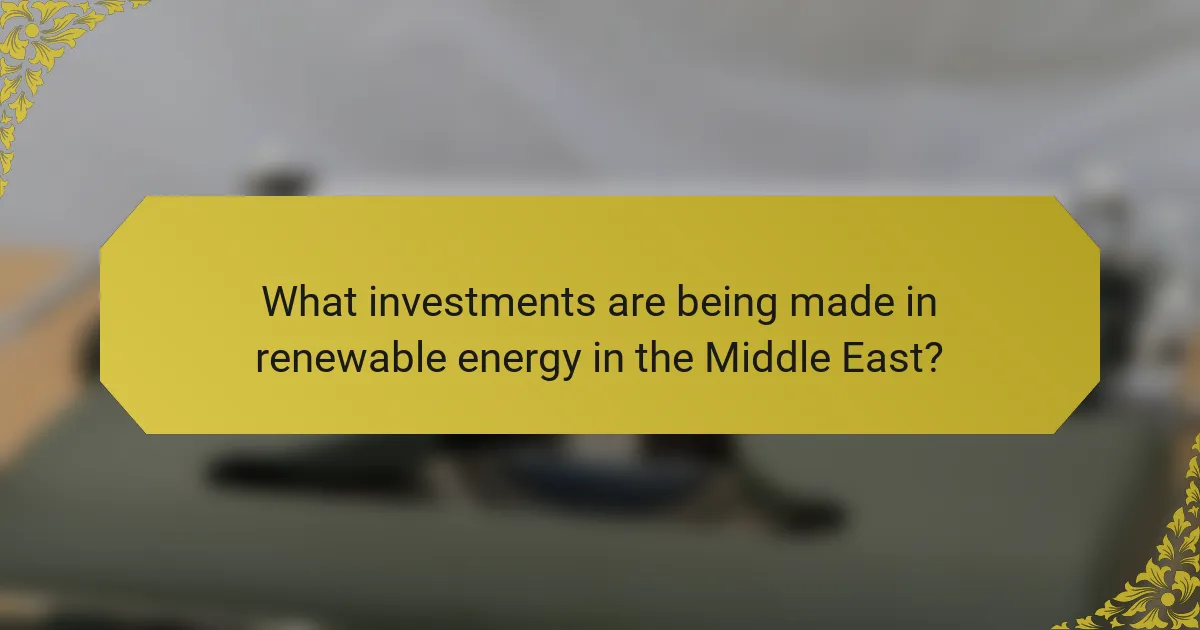
What investments are being made in renewable energy in the Middle East?
Significant investments are being made in renewable energy in the Middle East. Countries like Saudi Arabia and the UAE are leading the charge. Saudi Arabia’s Vision 2030 aims to generate 58.7 gigawatts of renewable energy by 2030. The UAE plans to invest $163 billion in clean energy projects by 2025. Qatar is investing in solar energy, targeting 1.8 gigawatts of capacity. Oman is focusing on wind and solar projects, with several initiatives underway. The region is also attracting foreign investments, with companies like Masdar and TotalEnergies involved in various projects. These investments are part of a broader strategy to diversify energy sources and reduce dependence on oil.
What are the major sources of funding for renewable energy projects?
Major sources of funding for renewable energy projects include government grants, private investments, and international financial institutions. Government grants often support initial project development and research. Private investments come from venture capitalists and corporations seeking sustainable returns. International financial institutions, such as the World Bank, provide loans and funding for large-scale projects. Additionally, green bonds have emerged as a popular financing tool for renewable energy initiatives. These sources collectively contribute to the growth and sustainability of renewable energy projects globally.
How do government initiatives support these investments?
Government initiatives support renewable energy investments through policy frameworks and financial incentives. These initiatives include tax credits, grants, and subsidies that lower the cost of renewable projects. For instance, the UAE’s Energy Strategy 2050 aims to increase the share of clean energy in the country’s energy mix to 50%. This strategy promotes investments in solar and wind energy. Additionally, governments often establish regulatory frameworks that facilitate project approvals and streamline processes. These frameworks help attract private sector investments by reducing risks. Moreover, partnerships with international organizations enhance funding opportunities. Overall, government actions create a conducive environment for renewable energy investments.
What role do private investors and international partnerships play?
Private investors and international partnerships play a crucial role in the development of renewable energy in the Middle East. They provide essential funding and resources to initiate large-scale projects. For instance, private investments can accelerate the deployment of solar and wind energy technologies. This financial backing is necessary due to the high initial capital required for renewable energy infrastructure.
International partnerships enhance technological exchange and expertise sharing. Collaborations with foreign companies often bring advanced technologies to the region. These partnerships can lead to improved efficiency and innovation in energy production.
Additionally, private investors can drive competition and lower costs in the energy market. They stimulate local economies by creating jobs and fostering entrepreneurship. The presence of international stakeholders can also attract more investments. This creates a positive feedback loop that supports the growth of the renewable energy sector.
Which countries in the Middle East are leading in renewable energy investments?
Saudi Arabia, the United Arab Emirates, and Israel are leading in renewable energy investments in the Middle East. Saudi Arabia has committed to investing $100 billion in renewable energy by 2030. The United Arab Emirates aims to generate 50% of its energy from clean sources by 2050. Israel is rapidly expanding its solar energy capacity, targeting 10 gigawatts by 2030. These countries are prioritizing renewable energy to diversify their economies and reduce dependence on fossil fuels. Their investments are supported by government initiatives and international partnerships.
What specific projects are being developed in these countries?
It is not possible to provide a specific answer about the projects being developed in these countries without additional context or details regarding which countries are being referred to. Each country in the Middle East is engaged in various renewable energy projects. For example, Saudi Arabia is developing the NEOM project, which includes large-scale solar and wind energy initiatives. The United Arab Emirates is advancing the Mohammed bin Rashid Al Maktoum Solar Park. However, without knowing the specific countries in question, a comprehensive answer cannot be provided.
How do these projects impact local economies?
Renewable energy projects significantly impact local economies by creating jobs and stimulating growth. These projects often require a skilled workforce for construction, operation, and maintenance. For example, a solar farm can generate hundreds of local jobs during its development phase.
Additionally, renewable energy projects can enhance local infrastructure. They may lead to improvements in roads, utilities, and communication systems. Increased energy production can lower electricity costs for residents and businesses.
Moreover, these projects can attract further investments in the region. A study by the International Renewable Energy Agency found that renewable energy investments can boost local GDP by up to 1.5% annually.
Local economies also benefit from increased tax revenues generated by these projects. This revenue can be reinvested into community services and development initiatives. Overall, renewable energy projects foster sustainable economic growth and resilience in local communities.
What challenges do investors face in the renewable energy sector?
Investors in the renewable energy sector face several challenges. Regulatory uncertainty can hinder investment decisions. Fluctuating government policies impact project viability. High initial capital costs create financial barriers for new projects. Technological risks can lead to project failures or delays. Market competition from fossil fuels affects profitability. Limited infrastructure can restrict energy distribution. Additionally, access to financing may be difficult in emerging markets. These factors collectively complicate investment in renewable energy projects.
How do regulatory barriers affect investment opportunities?
Regulatory barriers significantly limit investment opportunities in renewable energy. They create uncertainty and complexity for investors. Stringent regulations can delay project approvals and increase costs. For instance, in the Middle East, inconsistent policies hinder foreign direct investment. The World Bank reports that countries with clearer regulations attract more investments. In contrast, regions with heavy regulations often see reduced investor interest. Overall, regulatory barriers can stifle innovation and slow the transition to renewable energy sources.
What are the risks associated with financing renewable energy projects?
Financing renewable energy projects involves several risks. These include regulatory risk, which arises from changes in government policies or incentives. Market risk is another factor, as fluctuations in energy prices can affect project viability. Technological risk exists due to the rapid pace of innovation that may render existing technologies obsolete. Additionally, financial risk can occur if expected returns do not materialize. Furthermore, project development risks, such as construction delays or cost overruns, can impact financing. These risks can lead to decreased investor confidence and funding challenges. According to the International Renewable Energy Agency, understanding these risks is crucial for successful investment in renewable projects.
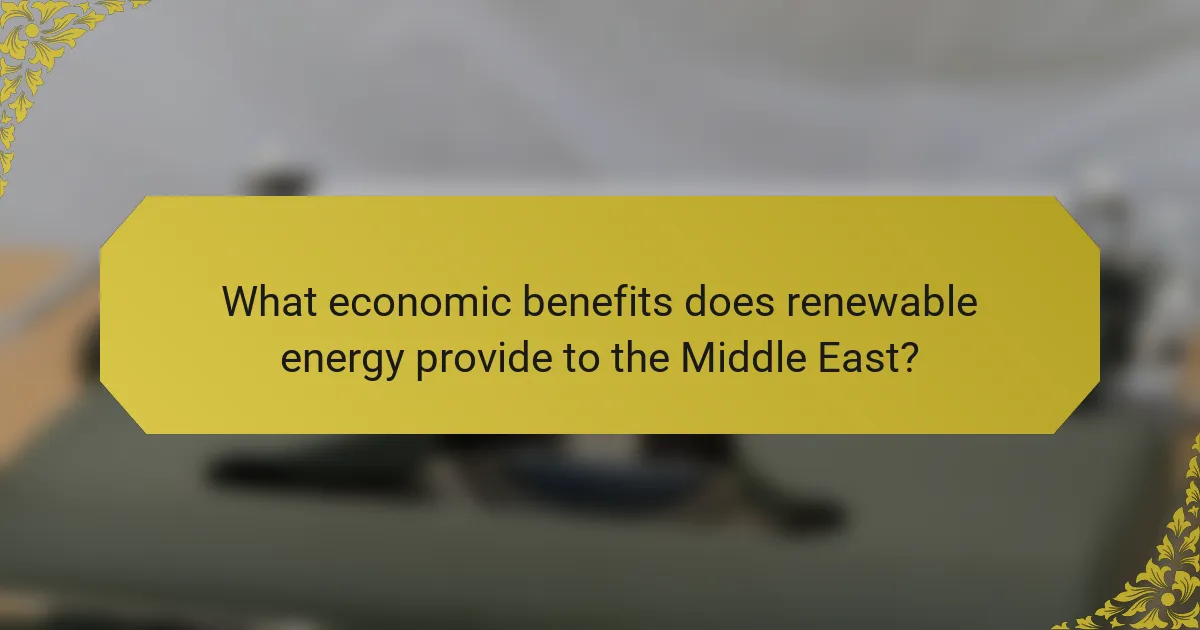
What economic benefits does renewable energy provide to the Middle East?
Renewable energy provides significant economic benefits to the Middle East. It reduces dependency on oil revenues, diversifying national economies. Investment in renewable technologies creates jobs in manufacturing, installation, and maintenance. The region can attract foreign investment by showcasing its commitment to sustainability. Renewable energy projects can lower energy costs for consumers and businesses. Additionally, they enhance energy security by reducing reliance on imported fuels. Countries like Saudi Arabia and the UAE are already investing billions in solar and wind energy initiatives. These investments are projected to contribute to economic growth and sustainability in the region.
How does renewable energy contribute to job creation in the region?
Renewable energy contributes to job creation in the region by fostering new industries and technologies. The growth of solar and wind energy sectors generates direct employment opportunities. For instance, the International Renewable Energy Agency reported that the renewable energy sector employed over 11 million people globally in 2018. In the Middle East, investments in renewable projects are projected to create hundreds of thousands of jobs by 2030. These jobs span manufacturing, installation, and maintenance of renewable energy systems. Additionally, local economies benefit from increased demand for skilled labor and related services. This shift towards renewable energy not only addresses energy needs but also stimulates economic development.
What types of jobs are generated by renewable energy projects?
Renewable energy projects generate various types of jobs, including installation, operation, and maintenance roles. These projects require skilled technicians for solar panel and wind turbine installation. Additionally, they create jobs in project management and engineering. Research indicates that the renewable energy sector has the potential to create millions of jobs globally. For instance, the International Renewable Energy Agency reported that 11.5 million people were employed in renewable energy worldwide by 2018. This trend is expected to continue as investments in renewable energy increase.
How does workforce development play a role in this sector?
Workforce development is crucial in the renewable energy sector. It ensures that the workforce possesses the necessary skills for emerging technologies. Skilled workers are essential for the installation, maintenance, and operation of renewable energy systems. According to the International Renewable Energy Agency, the sector could create millions of jobs by 2030. Training programs enhance employability and support economic growth. Investment in workforce development leads to innovation and efficiency improvements. Countries in the Middle East are increasingly recognizing this need as they diversify their economies. Thus, workforce development directly impacts the sector’s growth and sustainability.
What impact does renewable energy have on energy prices?
Renewable energy generally leads to lower energy prices over time. The increasing adoption of renewable sources reduces reliance on fossil fuels. This shift can stabilize and even decrease energy costs. For instance, the International Renewable Energy Agency reported that solar and wind energy costs have dropped significantly, by 82% and 49% respectively since 2010. As more renewable energy projects are developed, competition increases, driving prices down further. Additionally, renewable energy sources have low operational costs, which contribute to long-term price reductions. Therefore, the transition to renewable energy can create a more stable and affordable energy market.
How can renewable energy lead to lower energy costs for consumers?
Renewable energy can lead to lower energy costs for consumers through reduced operational expenses and increased competition. Renewable sources, such as solar and wind, have minimal fuel costs compared to fossil fuels. According to the International Renewable Energy Agency, the cost of solar energy has dropped by over 80% since 2010. This price reduction makes solar installations more affordable for consumers. Additionally, as more renewable projects enter the market, competition drives prices down further. Energy storage advancements also enhance efficiency, allowing consumers to utilize energy when prices are lower. These factors contribute to overall decreased energy bills for households.
What are the long-term economic implications of shifting to renewables?
Shifting to renewables has significant long-term economic implications. It can lead to decreased energy costs over time. Renewable energy sources, such as solar and wind, have low operational costs. The International Renewable Energy Agency (IRENA) reported that renewable energy could save economies up to $160 trillion by 2050. Job creation is another key implication. The transition is expected to generate millions of jobs in various sectors. Furthermore, energy independence can enhance national security and reduce reliance on fossil fuel imports. Investment in renewables can stimulate economic growth and innovation. Regions that embrace renewables may see increased competitiveness in the global market. Overall, the shift to renewables can foster sustainable economic development.
What are the environmental and social benefits of renewable energy investments?
Renewable energy investments provide significant environmental and social benefits. Environmentally, they reduce greenhouse gas emissions, mitigating climate change. According to the International Renewable Energy Agency (IRENA), transitioning to renewables could cut global CO2 emissions by up to 70% by 2050. This shift also decreases air pollution, leading to improved public health outcomes. Socially, renewable energy creates jobs. The Solar Foundation’s National Solar Jobs Census reported over 250,000 solar jobs in the U.S. in 2019, with growth expected in emerging markets. Additionally, renewable projects often enhance energy access in remote communities, fostering economic development. By investing in renewables, regions can achieve energy independence and resilience against price volatility in fossil fuels.
How does renewable energy improve public health in the region?
Renewable energy improves public health in the region by reducing air pollution. Transitioning from fossil fuels to renewable sources like solar and wind decreases harmful emissions. Lower emissions lead to fewer respiratory and cardiovascular diseases. For instance, a study by the World Health Organization found that cleaner air can reduce health care costs significantly. Additionally, renewable energy projects often promote community health initiatives. These initiatives can include better access to clean water and improved sanitation. Overall, the shift to renewable energy directly correlates with enhanced public health outcomes.
What role does community engagement play in renewable energy projects?
Community engagement plays a crucial role in renewable energy projects. It fosters local support and acceptance of initiatives. Engaged communities are more likely to participate in decision-making processes. This involvement can lead to better project outcomes and alignment with local needs. Studies show that projects with strong community ties often experience fewer delays and conflicts. For instance, a survey by the National Renewable Energy Laboratory found that community-backed projects had a 30% higher success rate. Effective engagement also enhances knowledge sharing and capacity building among stakeholders. Ultimately, community engagement is essential for the sustainability and success of renewable energy initiatives.
What practical steps can stakeholders take to maximize benefits from renewable energy?
Stakeholders can maximize benefits from renewable energy by investing in technology and infrastructure. Upgrading grid systems enhances energy distribution efficiency. Collaborating with local governments can streamline regulatory processes. Providing financial incentives encourages private sector investments. Educating communities raises awareness about renewable energy advantages. Establishing partnerships with research institutions fosters innovation in energy solutions. Implementing policies that support renewable energy projects can attract international investments. Monitoring and evaluating projects ensures continuous improvement and adaptation to market changes.
The primary entity of this article is renewable energy in the Middle East. The article provides a comprehensive overview of the future of renewable energy in the region, highlighting significant investments from countries like Saudi Arabia and the UAE, which aim to diversify their economies and reduce oil dependence. Key renewable sources discussed include solar, wind, and geothermal energy, along with the economic benefits such as job creation and lower energy costs. The article also addresses challenges investors face, regulatory barriers, and the role of technological advancements in shaping the renewable energy landscape. Additionally, it emphasizes the environmental and social benefits of renewable energy investments.
